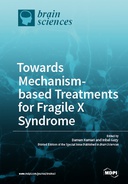Explore

Towards Mechanism-based Treatments for Fragile X Syndrome
Daman Kumari and Inbal Gazy
2019
0 Ungluers have
Faved this Work
Login to Fave
It has been more than 25 years since the identification of the FMR1 gene and the demonstration of the causative role of CGG-repeat expansion in the disease pathology of fragile X syndrome (FXS), but the underlying mechanisms involved in the expansion mutation and the resulting gene silencing still remain elusive. Our understanding of the pathways impacted by the loss of FMRP function has grown tremendously, and has opened new avenues for targeted treatments for FXS. However, the failure of recent clinical trials that were based on successful preclinical studies using the Fmr1 knockout mouse model has forced the scientific community to revisit clinical trial design and identify objective outcome measures. There has also been a renewed interest in restoring FMR1 gene expression as a possible treatment approach for FXS. This special issue of Brain Sciences highlights the progress that has been made towards understanding the disease mechanisms and how this has informed the development of treatment strategies that are being explored for FXS.
This book is included in DOAB.
Why read this book? Have your say.
You must be logged in to comment.
Rights Information
Are you the author or publisher of this work? If so, you can claim it as yours by registering as an Unglue.it rights holder.Downloads
This work has been downloaded 249 times via unglue.it ebook links.
- 69 - pdf (CC BY-NC-ND) at Unglue.it.
Keywords
- adeno-associated virus
- Anxiety
- ASD
- Attention
- Autism Spectrum Disorders
- automated vocal analysis
- avoidance
- base excision repair (BER)
- Behavior
- Best Practices
- Biology, Life Sciences
- biomarker
- Brain
- cerebral spinal fluid
- CGG Repeat Expansion Disease
- characteristics that have the greatest impact
- clinical trials
- Cognition
- cognitive flexibility
- Contraction
- CRISPR 3
- developmental disorders
- DNA instability
- DNA Methylation
- double-strand break repair (DSBR)
- Drug development
- early identification
- epigenetic gene silencing
- Executive Function
- expansion
- Females
- fibroblast
- FMR1
- FMR1 gene
- Fmr1 KO mouse
- FMRP
- Fragile X
- fragile X mental retardation protein
- Fragile X Syndrome
- Fragile X syndrome 1
- Fragile X-associated Tremor/Ataxia Syndrome 2
- Fxr2
- Gene editing
- gene reactivation
- histone methylation
- Inhibitory Control
- Intellectual Disability
- IPSC
- Language Development
- lymphoblast
- Mathematics & science
- mismatch repair (MMR)
- molecular biomarkers
- mosaicism
- n/a
- Neurodevelopmental Disorders
- newborn screening
- Non-homologous end-joining (NHEJ)
- Planning
- Pluripotent Stem Cells
- PRC2
- processing speed
- protein synthesis
- repeat instability
- RNA:DNA hybrid
- set-shifting
- targeted treatments
- thema EDItEUR::P Mathematics and Science::PS Biology, life sciences
- transcription coupled repair (TCR)
- treatment development
- Trinucleotide Repeat 4
- unstable repeat diseases
- viral vector
- voice of the patient
- voice of the person
- working memory
- X chromosome
Links
DOI: 10.3390/books978-3-03921-506-5Editions


